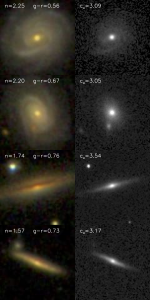
These panels show galaxies with intrinsically very similar stellar masses, SFRs, inclination-independent sizes and concentrations at two different viewing angles – the top panels nearly face-on, the bottom panels close to edge-on. The right-hand panels shows nearly attenuation-independent K-band images, whereas the left shows the SDSS gri-band cutouts, which are clearly affected dramatically by viewing angle.
Many commonly-used galaxy properties – luminosities, structures (Sersic index, half light radii, etc.), ‘dust-corrected’ SFR estimates, or emission line metallicities are all strongly affected by dust attenuation in ways that are not widely recognized.
Brian Devour and I recently published a Letter in the Monthly Notices of the Royal Astronomical Society where we tried to quantify the effects of dust attenuation on commonly-used measures of galaxy properties. We study how galaxy properties appear to change as a function of their viewing angle. Galaxies with dust are affected significantly more by dust attenuation in the edge-on orientation than in their face-on orientation, and the difference in properties between face-on and edge-on galaxies gives a robust and model-independent measure of the difference in dust attenuation between those two viewing angles (see e.g., Tully et al. 1998 for an example of this technique).
The trick is figuring out which face-on galaxies correspond to which edge-on galaxies. We used an uncommon technique – collapsing the light from a galaxy onto its major axis, which for long wavelength images should be independent of viewing angle and insensitive to dust attenuation – to match galaxies by their stellar masses, star formation rates and structures. This kind of analysis gives us a sample of galaxies that are very similar save for viewing angle, as shown to the left. One can see even by eye that measurements of galaxy luminosities, sizes, and concentrations will be dramatically affected by dust.
Quantitatively, we find that when inclining to edge-on, r-band luminosities dim by >1 magnitude, sizes decrease by a factor of 2, ‘dust-corrected’ estimates of star formation rate drop threefold, metallicities decrease by 0.1 dex (or 30%), and edge-on galaxies are half as likely to be classified as star forming.
This has important implications for statistical analyses of galaxy properties and their evolutions – these differences between face-on and edge-on quantities show that samples selected by e.g., star formation rate, luminosity or size will select face-on galaxies preferentially, giving a biased view of the galaxy population. We plan to expand the scope of this work in the next months to a wider variety of galaxy types, preparing the path for a less biased census of galaxy properties and their evolution.

